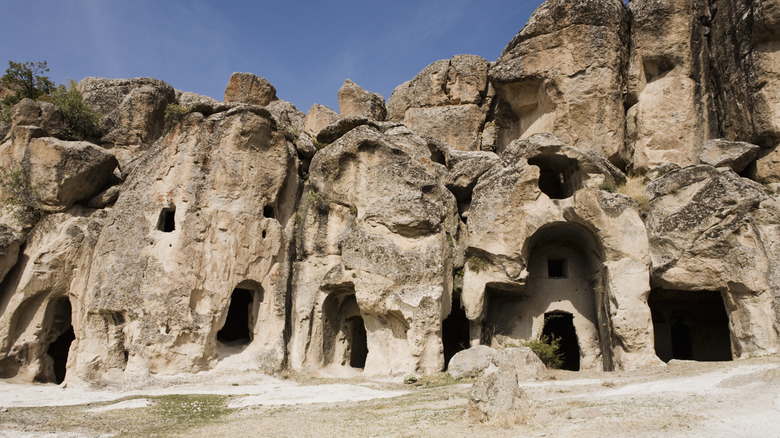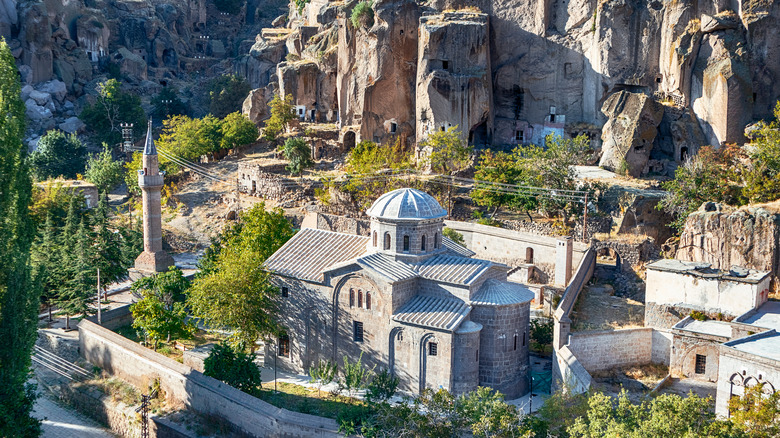This Off-Beat, Little-Known Turkish Town Is One Of Rick Steves' Favorites
Opulent palaces, bustling bazaars, and cosmopolitan glamor are the orders of the day in Istanbul (also home to one of the best airports for a layover), but travel a little further out into rural Turkey (Türkiye), and the environment changes dramatically. Several hours southeast of Istanbul sits Güzelyurt, a town that travel guru Rick Steves has dubbed one of his "favorite discoveries in this bizarre and fascinating corner of central Turkey."
The town is small, with a population of just 2,570 people in 2021, and according to Steves, it is nearly devoid of tourism. But that's a big part of its charm. While the fairy chimneys and ancient cliffside dwellings of the surrounding region of Cappadocia draw visitors by the busload, many head to Göreme and miss the small towns that Steves calls "cultural humidors — keeping fragile traditions moist and full of local flavor." Steves recounts being included as a special guest at a village wedding in Güzelyurt, something one imagines would be less likely to happen in a place that was overrun by tourists.
Guzelyurt's culture and history
Old guys playing backgammon in Turkey is a common sight, and Steves talks about the joy of joining in a game in Güzelyurt, but the ancient game is far from the only bit of history you will encounter in the town. Güzelyurt was a Greek Orthodox town prior to the "Great Population Exchange" of 1923. Following the fall of the Ottoman Empire, many Greek Christians were moved to Greece from their homes in Turkey and Turkish Muslims moved to Turkey from their Greek homes.
The Christian history remains with several churches that you can visit. One of the most culturally significant is the Güzelyurt Church Mosque (Büyük Kilise Cami), formerly St. Gregory's Church or St. Gregorious Church. It was built in 385 and restored in 1835, then converted to a mosque in 1924. It is thought to be the birthplace of the Gregorian Chant.
Also of note is Monastery Valley, which houses about 50 ancient churches that are carved into the cliff face. Most of them aren't open for exploration but a handful of them are, including Koç Kilesi with its 11th century angel fresco. Bear in mind that churches and mosques that are still sanctified as places of worship may have a modest dress code. It's one of the reasons the always-knowledgeable Steves recommends you don't wear shorts while traveling.
Exploring Cappadocia beyond Güzelyurt
The erosion of soft tufa stone has created hoodoos — the fairy chimneys the region of Cappadocia is famous for. You will see them in the area around Güzelyurt and further east. A popular way to see the otherworldly landscape is via hot air balloon, a once-in-a-lifetime vacation experience that will stay with you forever.
You may also want to take a hike through the region; walking is a nice way to connect with the land in a way you can't do from a car or bus. Many people choose to spend half a day or longer in the Ihlara Valley, checking out the cave dwellings and churches, and the excavated village of Aşıklı höyük that dates back to 8200 B.C.
If from the air or on the land isn't sufficient for your explorations, you can also go underground to see another aspect of the region. The underground cities were painstakingly carved beneath the earth centuries ago. The intricate corridors and rooms were protective homes for people escaping threats at various times throughout history ... right up until the early 20th century. Both the cities of Derinkuyu and Kaymakli were added to the UNESCO World Heritage List. Other cool underground cities are found at Tatlarin, Ozkonak, Mazi, and Ozluce.


